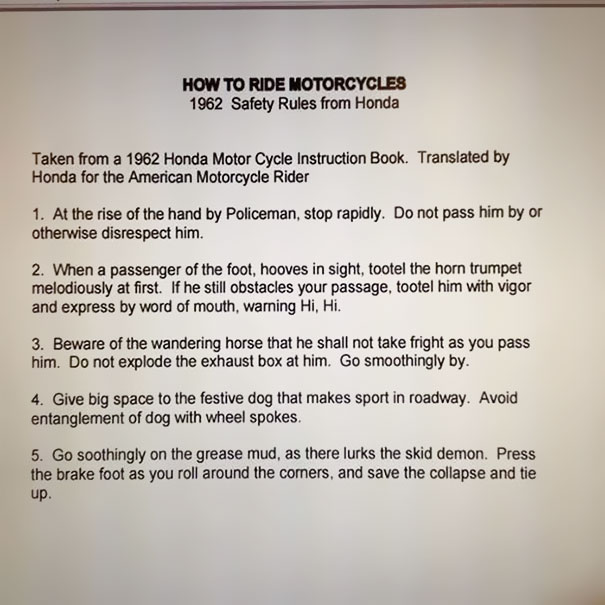When all else fails, read the instructions
July 20, 2020 Laura Moats

Image source: Bored Panda 65 Of The Funniest Product Instructions
Writing useful instructions
Imagine you’re Grandma. Your family gave you a Chromebook for Christmas. Now you can send them email, join Facebook, watch YouTube videos, and so much more. Your granddaughter is on the phone with you. She is explaining how to send an email.
Nicole: “Grandma, you need to navigate to Gmail.”
Grandma: “What is Gmail? is that the same as email? What do you mean by navigate?
Nicole: “You know; click on the Gmail icon.”
Grandma: “What is an icon? How do I click?”
Nicole: “Tell me what you see.”
Grandma: “A thin black rectangle, flat box-like thing…”
Nicole: “Grandma, you need to open it and turn it on!”
Those of you who are of a certain age can completely relate. Bad or incomplete instructions are frustrating for everyone. My dad always used to say, “When all else fails, read the instructions.” When the instructions are poorly written that is very hard to do. Why is it that so many instructions are so badly written?
Too much knowledge
When you are very close to a process and have done it a thousand times, you leave steps out. Nicole has used a computer millions of times. She was probably born with one in her hands. Grandma has never touched one before. Nicole assumes Grandma had opened the computer and turned it on.
Always write to the lowest level of knowledge your reader might have. If the instructions are for beginners, then assume they know nothing. If you assume the user has a certain level of expertise, you need to state this at the beginning as prerequisites.
Here’s an exercise I have used to teach technical writers to write instructions. I assigned each writer a partner. I asked each of them to teach their partner something the partner is unlikely to know, such as a favorite hobby. Each person writes up instructions. They then exchange instructions with their partners. The partner has to do the task using the instructions provided. Anytime the partner needs to ask for an explanation of the instructions, that means the instructions are incomplete. Think of it as a call to the help desk.
All the additions needed to make the instructions complete are noted. This served as an eye-opener for the writers. They realized how many steps they missed because of too much knowledge.
Too little knowledge
As an editor for a large technical writing department, I would often ask the writer if he or she understood what was being written. It was not uncommon to hear, “No, but the user will know.” That is a dangerous assumption. This happens especially when a lot of jargon and technical terms are used. If you don’t understand it, I can guarantee there are many others who will also not understand it. Write to the lowest knowledge level of your audience.
Poor writing and organizational skills
If your instructions consist of long rambling sentences, jargon, and do not follow a logical sequence, your audience is not going to read them. If it has too many notes, warnings, bold-faced, italicized, or CAPITALIZED text, the reader is not going to know what to focus on.
Solution: Improve your writing skills.
A tip to follow is that each step in an instruction should start with an imperative verb.
Bad: You should turn on the computer by pressing the little button on the right side.
Good: Press the button on the right-side to turn on the computer.
Each step in an instruction should consist of only one imperative verb. If you need to describe what happens after a step is executed, that is fine, but do not lead with it.
Bad: Your inbox is displayed after you turn on the computer and navigate to your email.
Good:
-
- Press the button on the right-side to turn on the computer. The screen lights when ready
- Click the image that looks like an envelope (email icon) to open your inbox.
Make each step clear and simple.
Bad Translations
Often instructions are bad because it was written in another language and then translated.
- Give big space to the festive dog that makes sport in roadway. Avoid entanglement of dog with wheel spokes. (1962 Safety Rules from Honda)
This is very common with products built in China. The initial manuals are written in Chinese, and a non-native speaker of English translates it. Although these can be quite comical, it emphasizes the need for good translation practices. (See When Writing Goes Wrong to learn more).
Everyone is a beginner once. Write clearly, concisely, and to the lowest knowledge level of your audience. If you aren’t sure, have Grandma test it.
